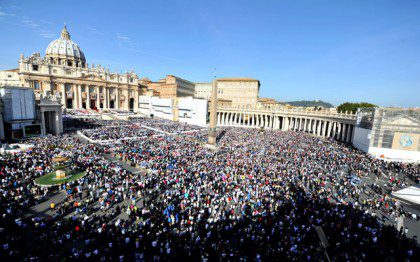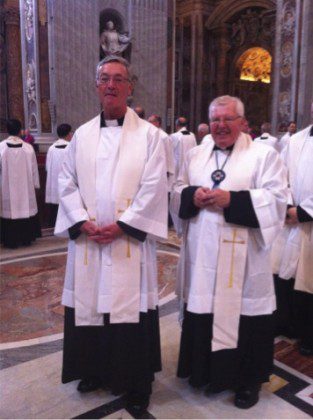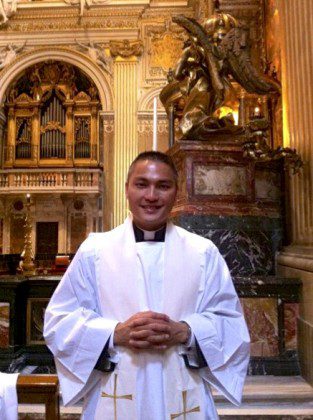
Provincial superior among those present at canonization of 1st Native American
Fr. Tom Cassidy, SCJ, provincial superior, and Fr. Tom Westhoven, SCJ, joined Fr. Francis Vu Tran, an SCJ student in Rome, at the October 21 canonization ceremony at St. Peter’s Square at the Vatican. Among those canonized was Kateri Tekakwitha, the first Native American saint. Fr. Cassidy wrote the following shortly after the ceremony:
Fr. Tom Westhoven. Fr. Francis Vu Tran and I went to St.Peter’s Square to join several hundred thousand pilgrims to witness Pope Benedict XVI canonize seven men and women, including Sister Barbara Cope, a German-born American who as a member of the Sisters of St. Francis of Syracuse, New York, ministered to lepers along with St. Damian De Veuster (Damian the Leper). Of special interest to us was the Pope’s raising to sainthood of Kateri Tekakwitha, the first Native American to be so honored. With Fr. John van den Hengel living here in Rome as Vicar General of our congregation, and a Canadian citizen, we had a lively discussion of what nation, Canada or the United States, should claim honors. In the end it was a draw as Kateri was born in what is now New York State long before the United States came into being, i.e, in 1656, and she died near present day Montreal on April 17, 1680.
During my 12-year stay here in Rome I always enjoyed Sundays in which the Pope beatified or canonized men and women as it frequently changed the character of the city. It certainly gave a sense of the true universality of the Church. Today was no exception! As the three of us walked out the door we were immediately met by a group of Filipinos who were boarding a bus just outside Villa Aurelia (our SCJ-owned guest house/hotel). They were here along with several thousand fellow countrymen and women to honor one of their own, Pedro Calungsod, who was martyred in 1672 on Guam along with Padre Diego Luis de San Vitores, SJ, who was beatified in March of 2000 by John Paul II.
Just as it was easy to spot the Philippine presence so too was it easy to notice the Native Americans from both the United States and Canada. On our way over from the States there was a large contingent of Native Americans on our flight, including a group of 40 who were being led by the Archbishop of Santa Fe, New Mexico.

There were two deacons from the Sioux Falls Diocese present. Fr. Tom Westhoven brought along cassocks so they could be a part of those priests and deacons who would be distributing communion. Fr. Tom took the cassocks to the hotel where the deacons were staying. As it turned out the deacons were staying at the Hotel Ciceroni located near the Vatican. The Ciceroni is the hotel where Dn. David Nagel and I stayed when Bishop Dimmerling from Rapid City had a tour group on one of his ad limina visits. That trip was compliments of Mary Giles, a retired school teacher who served as sacristan at St. Joseph Indian School for a number of years.
Fr. Francis was able to obtain tickets so the three of us would distribute communion during the liturgy. This requires that the priest or deacon must come in cassock. Fr. Francis scoured among his friends in Rome for cassocks that would fit the two of us. Mine came from the Mexican House of Studies. Fr. Tom and I are pictured here in St. Peter’s in full dress. The Vatican provides the stole and surplus.
We were required to arrive at St. Peter’s at 8:00 a.m. and go to the Eucharistic chapel. Ceremonies like this one are commonplace at St. Peter’s. I must say they are well organized. In an area not far from us those priests and bishops who would be concelebrating were dressing. We 150 priests and deacons were quickly given surplices and stoles. Directions were given in Italian with a brief recap in English. I could sum it all up as: “FOLLOW THE MASTER OF CEREMONIES and they’ll show you what to do.”
We were ushered out to the platform where the Pope would celebrate the Mass. Half of us were to the right of the altar and our group was on the left. In front of us were various dignitaries and special groups chosen to be on the platform. The liturgy itself was divided into two parts. The first (before Mass began) was the right of canonization. It consisted of (1) The Litany of Saints; (2) First Petition by Cardinal Angelo Amato, S.D.B., Prefect of the Congregation of Saints, requesting that the Holy Father raise these seven to the rank of saints; (3) Second Petition calling upon the Holy Spirit followed by the Veni Creator Spiritus sung by the schola and those present; (4) a final Third Petition followed by the Pope promoting the beatified to sainthood.
With this the Mass began with the penitential rite. The pope’s homily lasted about 15 minutes and included references to those raised to sainthood. While the Mass was done in Latin, the pope spoke in Italian and when referring to the saints spoke in the language appropriate to the individual. This included English, German, French and Italian. One other touch to the universality of the Church took place with the petitions as these were done in English, a Native American language, German, Spanish and a Philippine language.

As the offertory began the priests and deacons who were to give out communion were led to an area where we picked up a ciborium and then processed in front of the altar for the Eucharistic Prayer. The pope used the Third Eucharistic Prayer as this one provides a space to mention saints names. After all present sang the Our Father the 150 priests and deacons who were to give out communion were led down the main aisle and hooked up with an usher who had a open umbrella (done in the papal colors of white and gold). The purpose of the umbrella was to make it easy for the faithful to see where communion would be given out. My first post was right down the main aisle between the altar and in front of the obelisk. When we were done in that area I moved to another spot and stayed there until I was told it was time to go. I don’t know how many were not able to receive communion but there were at least some in my area. That being said I think the Vatican does an excellent job at organizing for these large crowds.
When we were finished giving out communion we were led back to the basilica to hand in our ciborium and return the stoles and surplices. Frs. Francis, Tom and I exited St. Peter’s and headed for the bus stop hoping to beat the crowd. We were successful and took a packed #881 bus back to Piazza Pio XI in plenty of time to take a shower and get ready for 1:00 p.m. pranzo (lunch).
It goes without saying that Fr. Tom and I are very grateful to Fr. Francis Vu Tran for all his efforts to put this day together for the two of us. Fr. Francis, now in his third year here in Rome studying Scripture at the Gregorian, has learned his way around the city and the Vatican.

